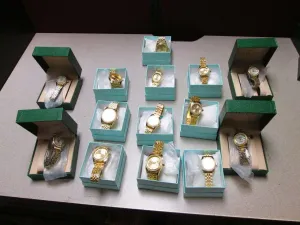CHICAGO– U.S. Customs and Border Protection (CBP) officers at Chicago O’Hare’s International Mail Branch, seized a shipment last night containing 67 pieces of counterfeit designer watches, bracelets, handbags, and scarves. The items were deemed to be counterfeit by CBP’s Centers of Excellence and Expertise, the agency’s trade experts, and if genuine, would have had a combined Manufacturer’s Suggested Retail Price (MSRP) over $1 million.
The shipment arrived from Thailand. When CBP officers examined the shipment to determine the admissibility of the goods, they found 53 watches displaying the logos of Rolex, Gucci, Hermes, and Louis Vuitton, 9 bracelets with Rolex logos, 3 counterfeit Louis Vuitton handbags, and 2 counterfeit Gucci scarves. The items were poorly packaged and constructed and were seized for infringing on the designer’s protected trademarks. The shipment was heading to a residence in Oklahoma and had the items been real, the MSRP for these products would have been $1.08 million.
“Counterfeit goods are poor quality products that cost U.S. businesses billions of dollars a year while robbing our country of jobs and tax revenues,” said LaFonda D. Sutton-Burke, Director, Field Operations, Chicago Field Office. “CBP officers throughout my field office remain committed to stopping counterfeit smuggling, taking profits from organized crime, and helping protect our communities from potentially hazardous knockoffs.”
CBP data indicates handbags, wallets, apparel, footwear, watches, jewelry, and consumer electronics are at a higher risk of being counterfeited. Counterfeit versions of popular brands are regularly sold in online marketplaces and flea markets. Not only are counterfeit goods produced in unregulated and potentially exploitative environments in foreign countries, but the profits from their sales provide a funding stream to organized crime.
Nationwide during Fiscal Year 2022, CBP seized over 24.5 million shipments with Intellectual Property Rights violations worth just shy of $3 billion, had the goods been genuine. CBP protects citizens from unsafe and substandard products by seizing merchandise infringing on trademarks and copyrights recorded with CBP through the e-Recordation program https://iprr.cbp.gov/s/. CBP has established an educational initiative to raise consumer awareness about the consequences and dangers associated with the purchase of counterfeit and pirated goods. Information about the Truth Behind Counterfeits public awareness campaign can be found at https://www.cbp.gov/FakeGoodsRealDangers.
“To cut costs and maximize profits, counterfeit products are often made of inferior materials, are manufactured under uncontrolled and unsanitary conditions, and are labeled with false product information. Plus, they also just look bad,” said Chicago’s Acting Area Port Director Michael Pfeiffer.
Counterfeit goods can often be spotted by their inferior quality. Peeling labels, low-quality ink or printing errors on the packaging, and loosely packed items in the box can be signs the product you purchased may not be legitimate. Counterfeit apparel and handbags may feature poor or uneven stitching and improperly sized or designed logos. The performance of counterfeit electronics is often marked by short battery life and regular overheating.
Consumers can take simple steps to protect themselves and their families from counterfeit goods:
- Purchase goods directly from the trademark holder or from authorized retailers.
- When shopping online, read seller reviews and check for a working U.S. phone number and an address that can be used to contact the seller.
- Review CBP’s E-Commerce Counterfeit Awareness Guide for Consumers.
- Remember that if the price of a product seems too good to be true, it probably is.
CBP’s border security mission is led at 328 ports of entry by CBP officers from the Office of Field Operations. Please visit CBP Ports of Entry to learn more about how CBP’s Office of Field Operations secures our nation’s borders. Learn more about CBP at www.CBP.gov.


